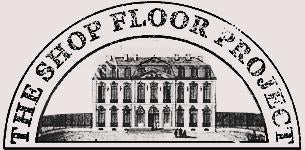
Product Details
Handmade tile by Edith Morris exclusively for The Shop Floor Project. Made in Cornwall, England. Arrives gift boxes with maker's story.
Size: 12.2 x 12.2cm (1.5cm depth) / 4.8" x 4.8" (0.6" depth)
Material: Glazed stoneware, hanging hole on reverse if wall display is required.
Please note: due to the handmade nature of these objects, each tile is slightly different.
Folktale: The manticore, or 'maneater', has the face of a human, the body of a lion and the tail of a scorpion. It eats its victims whole, using its three rows of teeth, and leaves no bones behind. Look closely at the man lying under the manticore's paws in Edith Morris' version.
THE STORY

The Shop Floor Project commissioned Cornwall-based artist Edith Morris to create a collection of tiles inspired by European folklore and the ancient craft of pargeting - a perfect pairing for this artist.

Growing up in South Wales and living in Cornwall, Edith Morris has been immersed in Celtic folklore from a young age, which has always inspired her work. For this collection we asked Edith to explore the folklore tales of Europe, including Celtic, Nordic, Scandinavian, Baltic and Slavic traditions. Many of these tales have pagan roots, often predating Christian beliefs, and are closely tied to nature, the seasons and ancient rituals.

After seeing Edith's work, we were instantly reminded of the ancient tradition of pargeting, a type of lime plaster decoration applied to the outside of houses in medieval England.

Most popular in the south east of the country, the decoration often depicted local folklore such as the legendary figures of Tom Hickathrift and the Wisbech Giant as shown on the gable of the magnificent 14th century Sun Inn in the town of Saffron Walden (below.)

With these reference-points to work with, Edith set off researching folk tales and began working on her drawings, bringing these ancient legends to life.

Once happy with the drawings, Edith then painstakingly hand carved the master tile, which she then secured in a handmade wooden mould.

From here stoneware clay was carefully pressed into the mould and allowed to dry.


After a first bisque firing, Edith applies one of the glazes she has created specifically for that design.

One of the most exciting stages of the collection development was seeing the glaze testers that Edith was working on. It was fascinating to see how she wanted to create a palette of various glazes that were all white, yet slightly different from each other, to create a sense of animation and antique quality throughout the collection.

Similar to the lime pargeting on the walls of the houses, some of the glazing is a thick milky white such as the Bellasheep Head milkmaid tile (below).

Whilst other designs are glazed thinner, revealing more of the clay and appearing like an iced-gingerbread biscuit.

Other tiles are flecked with oxidised stoneware, which almost feels like flakes of snow falling, as shown in The Midnight Washer Women (below).

Looking over the whole collection, it's as though we have stumbled across an ancient inn in the forest which is tiled in these stories of local legends, mythical beasts and strange woodland plants.

The mythical tales which Edith has depicted include giant creatures that roam the countryside, terrorise ships and celebrate the seasons. Tales of a monster boar that only King Arthur could defeat, a man eating lion, a headless man with eyes on his chest and a rather scary, yet beautiful, giant Icelandic cat called Jólakötturinn or the Yule Cat.

Plants are central to myths and folklore, especially woodland species, and Edith has created three beautiful designs as part of the collection; an unfurling fern, an anemone and the brand of an oak tree.

Like scenes in a play, each one stands alone with its magical story contained within a single tile.

Grouped together they become a mosaic of folktales, an archive of glazed stories and a way to continue this oral tradition of sharing stories of myths and legends that have come out of the mists of time.

As the light in the room changes throughout the day, and the year, the characters will move with the shadows, animating the scenes and bringing different areas and details to life. And the details Edith creates are incredible.

Look at the intricate detailing in the ship on the Stoorworm tile (above), peer into the mirror that the mermaid is holding (below) and you will see her reflection.

Look under the paws of the manticore, can you see the man being eaten? And are those archers shooting at a giant boar on a hill? The incredible observation of a fish that the griffin has caught and even the wonderfully hairy legs of the headless man in the forest are a joy to behold!

Edith Morris studied theatre design at Bristol University. As well as designing stage sets, she also makes films (with recent residencies to Slovenia, Iceland and Norway) and makes ceramics in her studio in Cornwall.













































